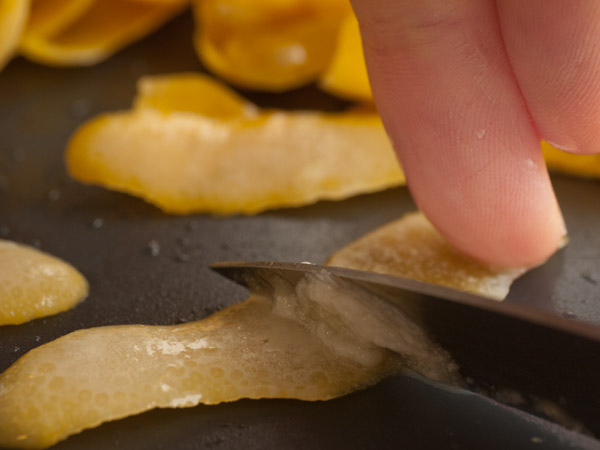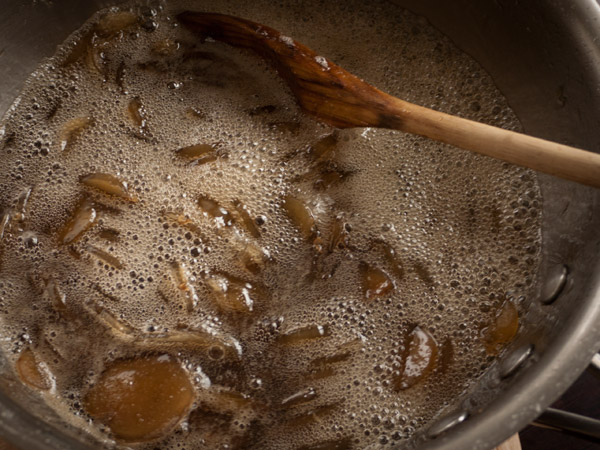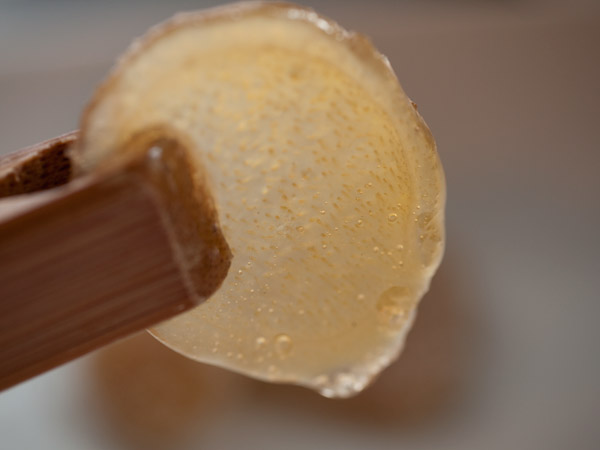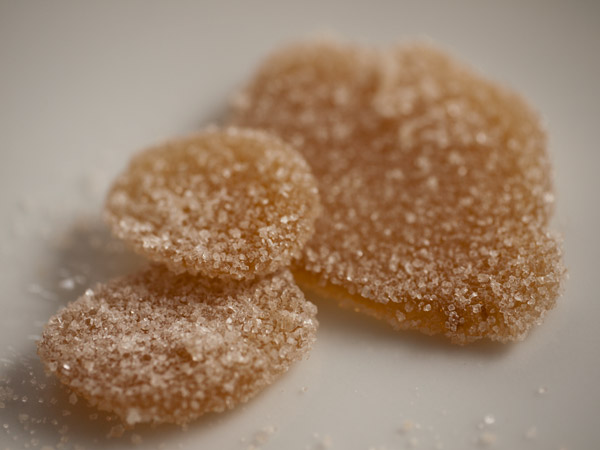
I really thought candied ginger would be easy. Slice up some ginger, blanch it, put it in a pot with equal parts sugar and water, and heat to 225°. Straightforward, precise directions. I even had a thermometer — not a candy thermometer, but an accurate instant-read meat thermometer that I figured should do the trick.
You can see where this is going. After blanching, three hours of boiling, overnight soaking in their syrup, then individually fishing out the ginger coins and laying them on a pan to dry all afternoon, my ginger slices were all wrong; grainy and wet and crystalized. Sure, they were still delicious, but where were the chewy, golden, translucent coins with just a hint of stickiness that I'd expected?
Here's the thing, though. Just for the heck of it, I poured half of the gingery syrup back into the pot, then blanched a bunch of lemon peels and tossed them in. An hour later I had beautiful strips of perfectly candied lemon peel without even a hint of graininess. What happened?
As far as I can tell, there were two key differences: temperature and interfering agents.
As far as I can tell, there were two key differences: temperature and interfering agents.
Temperature
In making candy, a matter of degrees can completely change the texture of the end product. Say you start with a 50/50 mix of sugar and water. Initially, it boils at 212° (the boiling point of water at sea level). The longer you cook your sugar-water syrup, the more water evaporates, and the higher the sugar concentration in the syrup. The higher the sugar concentration, the higher the temperature can go, and the harder the candy will be when you cool it back down.
You've heard your grandmother in the kitchen muttering about "hard crack"? She's talking about syrup that's been heated to around 300°. Drop some of that into cold water, and you get brittle threads of sugar. If you only heat it to 270° or so, you get flexible threads — the "soft crack" stage. And you thought grandma was so badass.
By using the wrong thermometer, I may have gotten an inaccurate reading and under-heated the syrup when I made the ginger. Lower temperature = lower sugar concentration = lousy results. When I made the lemon peels, though, I was dropping them into syrup that was already pretty concentrated, so the temperature went much higher much more quickly.
By the time I checked the temperature, it had already reduced further, and the temperature was up to 240°. I tasted a piece of peel, but it was still tough, and tasted like lemon peel dipped in syrup. At this point, it occurred to me that the syrup might be too thick for the peels to absorb, and they should probably cook longer... but not necessarily hotter. I cooled the syrup back down a bit, added another cup of water and brought it back up to temperature over the next half-hour. (Pouring cold water into 240° sugar syrup seemed like a good way to get scalded.) That did the trick. I don't think the up-and-down made much difference in the results, but the fact that the final temperature was 240°+ certainly did.
 |
| Slicing strips of lemon zest. |
 |
| I also blanched some lemon peel, pith and all, and after 10 minutes of simmering, the pith scrapes right off. Much easier than shaving strips of zest off the lemon. |
 |
| Candied lemon peel, cooling on waxed paper. |
Interfering agents
This part's even cooler. It turns out that adding a small amount of certain "interfering agents" will inhibit the formation of sugar crystals. Common interfering agents include:
• acid (e.g. cream of tartar, lemon juice)
• non-sucrose sugars (corn syrup, fruit juice, honey, glucose)
• fat (butter or cream)
• protein (milk, egg white, gelatin)
• acid (e.g. cream of tartar, lemon juice)
• non-sucrose sugars (corn syrup, fruit juice, honey, glucose)
• fat (butter or cream)
• protein (milk, egg white, gelatin)
So, did the higher temperature of the lemon fix the problem? Did the lemon peels have enough acidic lemon juice to interfere with crystallization? Or could it be something about the pectin provided by the lemon pith?
I could figure it out with a series of carefully controlled test batches, changing one factor at a time. Or I could just make one batch with all the likely factors and guarantee success, without dirtying any extra pots or making additional trips to the grocery store.
I love science, but I really didn't feel like going back to the grocery store.
I mixed the sad, failed ginger slices with the lemon-ginger syrup, and added what was left of the grainy, hard ginger syrup from the original batch. To be on the safe side, I also added a few tablespoons of lemon juice. I heated the whole thing back up to 150 (according to my thermometer, which may or may not be accurate), and fished the ginger back out.
This time, it worked. Beautiful, golden, translucent ginger slices, firm and chewy and smooth and beautiful. Sticky instead of wet, they took a coating of granulated sugar beautifully.
The extra syrup stayed smooth and clear and crystal-free, even when it cooled. Re-melted with chopped-up ginger scraps, poured onto a buttered baking sheet, re-cooled and sliced, it made perfect ginger chews.

Recipe notes:
I started with David Lebowitz's instructions. Like I said above, I used the wrong kind of thermometer (and didn't do the cold water test as a backup) so it's possible (okay, likely) that his instructions are just fine and the fault was mine. On the other hand, I don't think you'll have a problem if you add 2 Tbsp of lemon juice with the sugar and heat it to 235° or 240° instead of the 225° he recommends.
Also, he said to cut the ginger slices as thin as possible. I did a range of thicknesses to see how the texture varied. Thicker slices have, to my taste, the better ginger-to-sugar ratio, but you do end up with more of the tough ginger fibers. Didn't bother me, but my husband found them a little annoying. Young ginger (not always available) has fewer and thinner fibers.
Finally, Lebowitz says to tenderize the ginger by blanching it twice, pouring off the water each time. I did this, and found that the finished ginger slices weren't as intense as I like them. Next time, I'm going to skip the blanching and just put the fresh ginger right into the simple syrup. I'm pretty sure the total cooking time will be long enough for the ginger to get tender, and that way it won't lose any of the spicy goodness. Note: I like my ginger really intense. The blanching method is probably a good idea for normal people.
Finally, Lebowitz says to tenderize the ginger by blanching it twice, pouring off the water each time. I did this, and found that the finished ginger slices weren't as intense as I like them. Next time, I'm going to skip the blanching and just put the fresh ginger right into the simple syrup. I'm pretty sure the total cooking time will be long enough for the ginger to get tender, and that way it won't lose any of the spicy goodness. Note: I like my ginger really intense. The blanching method is probably a good idea for normal people.







